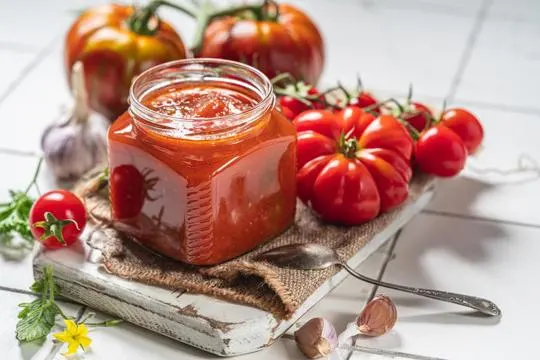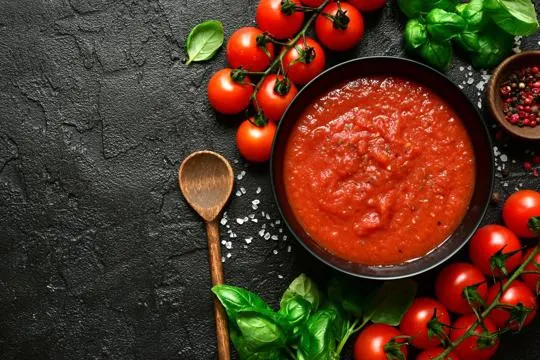Summary of key points
The primary difference between tomato passata and tomato paste is their consistency and concentration. Tomato passata is a lightly cooked, pureed tomato sauce that is strained to remove seeds and skins, offering a smooth texture and fresh flavor. Tomato paste, however, is highly concentrated and cooked down to remove most of the water content, resulting in a thick paste with a deep, rich tomato flavor.
Ever found yourself staring at the grocery aisle, trying to pick between tomato passata and paste? We’ve been there.
Seriously, they both look tomato-y, they’re both packed in jars or cans, and they both claim to be the secret ingredient your spaghetti sauce is missing. What gives?
Here’s a fun fact: I once used tomato paste instead of passata in a recipe. The results? Not what I expected.
Spoiler alert: my sauce was so thick, you could almost cut it with a knife. Learned my lesson.
Tomato passata is smooth and saucy. Tomato paste? It’s thick, concentrated, and not kidding around.
They’re not interchangeable. They play different roles in our kitchens.
Stay tuned. We’re about to dive deep into the world of tomatoes without making your head spin. Promise, it’s simpler than it sounds.
What is Tomato Passata?

Tomato passata is a pureed tomato sauce that’s thick and smooth.
It’s got a velvety texture and bright red color.
So it’s used in Italian dishes like pasta sauces, soups and stews.
The tomatoes used are usually ripe, juicy and full of flavor.
Passata is different from tomato paste.
It’s smoother and thinner than paste.
It gives great tomato flavor, without the extra thickness.
Passata is sometimes seasoned with herbs and spices.
Or used as a neutral base for more individual seasoning.
This ingredient adds richness to dishes, while keeping the freshness of tomatoes.
What is Tomato Paste?

Tomato paste is a thick, intense form of tomatoes.
It’s cooked to reduce water content and has a beautiful red hue.
This paste is so versatile – it can be used as a base for sauces, soups, stews, and even pizza toppings.
Plus, it’s an excellent flavor enhancer and a natural thickener.
Don’t forget the storage benefits, either.
Tomato paste comes in convenient packaging that doesn’t need refrigeration.
So, it’s an ideal pantry item for regular cooks.
To sum up, tomato paste is a must-have ingredient.
Its concentrated form brings a delicious intensity to your meals.
Whether you’re making pasta sauce or soup, adding tomato paste will elevate the flavors and bring richness to your dish.
Differences Between Tomato Passata and Tomato Paste

Tomato passata and tomato paste may look similar, but they are different.
Texture and Consistency
When it comes to tomato passata and paste, there’s a clear difference.
Passata is smooth and liquid-like. It’s perfect for stews, sauces and soups.
But tomato paste has a denser consistency.
It’s used as a flavoring or thickening agent.
Passata has a velvety texture.
Blending into dishes, it adds delicious flavor.
With its thin consistency, it doesn’t overpower other ingredients.
Tomato paste is intense.
Its thick consistency clings to food, creating a bold flavor.
Used sparingly, it’s amazing in bolognese sauce and pizza.
In summary, passata offers a light texture, great for blending flavors.
Paste gives a strong taste, adding depth to dishes.
Both are invaluable in cooking, depending on the finished dish.
Cooking Applications
Tomato passata and tomato paste are both kitchen staples – but what sets them apart? Cooking applications of these two tomato products differ.
Passata has a smooth consistency, making it great to use as a base in soups, stews, and sauces.
It adds depth and richness to dishes.
Passata can even be used as a pizza topping or breadstick dip.
Tomato paste is much thicker and more concentrated.
This intensifies its flavor, making it great for dishes that require a strong tomato taste.
A bit of tomato paste can enhance the flavors of sauces, chili, and braised meats.
It’s also a spread on sandwiches and a marinade for grilled veggies.
When making homemade ketchup or BBQ sauce, tomato paste is valuable.
Its thick texture helps achieve the right consistency without losing flavor.
It can even add umami notes to veggie dishes.
When it comes to cooking with tomato passata or paste, each has distinct uses.
Passata is great for bases and adding complexity.
Paste brings boldness and intensity to dishes that need robust flavors.
Pick the right one for your culinary endeavors.
Flavor Profile
Tomato passata and tomato paste have very different flavor profiles.
Passata has a smooth texture with sweet and acidic notes, good for sauces or soups.
Paste has an intense flavor and can be used as a base for marinades or to add depth to stews.
These contrasting flavors can make your dishes unique.
Both are versatile and cater to different preferences.
Embrace the different flavors to enhance your cooking.
Processing Method
Tomato passata and paste differ in processing.
Passata is made by straining cooked tomatoes, giving a smooth, liquid texture.
Paste is created by cooking tomatoes down to a thick consistency.
This affects taste and thickness.
Passata is made by cooking fresh tomatoes until soft, then sieving or milling to remove seeds and skin.
It’s smooth and pourable, and great for sauces, soups, and stews.
Tomato paste undergoes a more intense process.
Tomatoes are cooked to reduce water content and concentrate flavor.
Any remaining seeds or skin are strained, and the product is packaged in cans or tubes.
Paste has a thick texture and intense flavor, perfect for chili, curry, and BBQ sauce.
The acidity of passata and paste also differs.
Passata has a higher pH level due to its shorter cooking time.
This impacts the flavor of dishes that incorporate these ingredients.
Similarities Between Tomato Passata and Tomato Paste

Tomato passata and tomato paste: similar but different.
Both products come from tomatoes, but go through different processes.
Passata has a smoother consistency, with fresh flavors.
On the other hand, tomato paste is thick and concentrate, with bold flavors.
Passata is strained to remove solids.
It’s liquid and has natural sweetness and acidity.
Great for sauces and soups; adds a bright, tangy flavor.
Tomato paste is cooked longer, reducing water.
It’s paste-like, with a deep, rich flavor.
Perfect for stews, braises, and marinades.
In conclusion: passata and tomato paste, both made from tomatoes.
Different textures and flavors; perfect for different culinary applications.
Recipes and Dishes Using Tomato Passata and Tomato Paste
Tomato Passata and Tomato Paste are must-haves for many recipes.
They bring unique flavors and textures to your dishes.
Passata is a puree, usually used as a base for pasta sauces, soups, and stews.
It has a velvety feel and mixes well with other ingredients.
Tomato paste, on the other hand, has a concentrated taste.
It’s perfect for adding depth and intensity.
Its thick texture works great in braises, marinades, and gravies.
A small amount of paste can go a long way.
For specific recipes, the possibilities are endless.
Passata stars in classic Italian dishes like spaghetti Bolognese and lasagna.
Meanwhile, paste shines in beef stew or chili con carne.
Its intense nature adds complexity to slow-cooked meals.
Both passata and paste can be used together in recipes like pizza sauce and barbecue marinade.
The passata gives a smooth base and the paste adds flavor.
Conclusion
In conclusion, it’s clear that there is a difference between passata and paste.
While both are terms related to tomatoes, the former describes chopped tomatoes cooked in their own juices and canned into containers or jars.
The latter, on the other hand, implies pureed tomatoes that have been cooked and canned.
However, many companies now offer a combination of the two products which effectively blurs the line between what was once considered two separate items.
Nevertheless, understanding the distinction between these tomato products can help you make the best purchasing decision when it comes to making your favourite dishes.
The next time you’re looking for a ready-made tomato product for your recipe, consult this article to determine if passata or paste would be more suitable – you won’t regret it.
